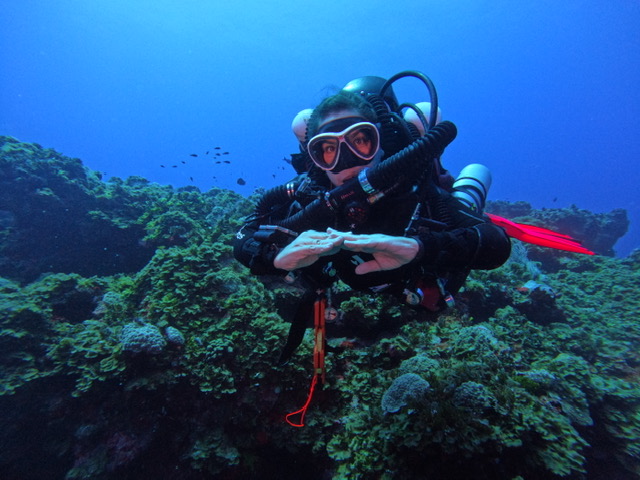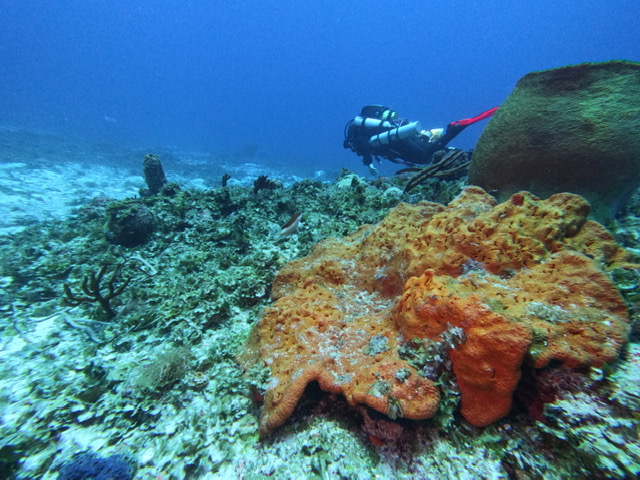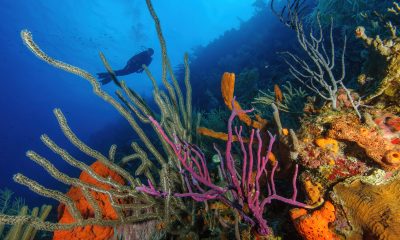Blogs
Halfway Through Expedition Hope: Do Offshore Seamounts Mean Good News for Cayman’s Coral Reefs?

As we near the half-way point of the Central Caribbean Marine Institute’s (CCMI) Expedition Hope to characterise the biodiversity of two offshore seamounts in the Cayman Islands, CCMI would like to reflect on the exciting exploration and substantial achievements made through the project so far.
Funded by the UK Government’s Darwin Plus Programme, CCMI and project partners, the Cayman Islands Department of Environment, Guy Harvey Ocean Foundation, and Smithsonian Tropical Research Institute, have collected a wide range of data to describe the benthos and biodiversity of the previously unexplored seamount, 12-Mile Bank. This valuable information will support improved management of ecologically significant and poorly understood seamount habitats in Cayman, providing evidence into the Cayman Islands Government Biodiversity Action Plan.
In August 2023, 12 miles west of Grand Cayman at 12-Mile Bank, CCMI’s technical scientific divers, in collaboration with the University of Delaware, Harbour Branch Oceanographic Institute, and the Smithsonian Tropical Research Institute, explored uncharted waters and documented the biodiversity on the seamount up to depths of 50 meters.
During the research expedition, the team completed twice the initial number of proposed fish surveys and 20% more benthic photo-mosaics, in addition to collecting samples for eDNA and genetic connectivity assessments and producing a bathymetric map of 12-Mile Bank.
CCMI have also produced a three-part docuseries, Expedition Hope, that follows the team’s journey to explore and document these never-before-seen reefs, including the challenges they encountered and the hope these ecosystems may provide for coral reefs. This gripping tale of female-led ocean exploration premieres on CCMI’s YouTube channel at 12pm on Friday 15th December.
Part 1: https://youtu.be/aIxIgvvVr4E
Part 2: https://youtu.be/NjAFh9-mhpU
Part 3: https://youtu.be/mssrMIpFWqc
As shown in the Expedition Hope series, there is a reason these seamounts remain largely unexplored, as weather conditions are rarely conducive with research expeditions. The initial efforts to reach the second seamount, Pickle Bank, were curtailed by bad weather, but the team will not be deterred that easily. In spring/summer 2024, CCMI’s researchers and project partners will focus their efforts on characterising Pickle Bank, a seamount 45-miles offshore, north of Little Cayman.
Both Pickle Bank and 12-Mile Bank are classified as Vulnerable Marine Ecosystems under international criteria and are thought to be home to rich biodiversity with fewer impacts from human activity due to the remote location. The first expedition indicated that 12-Mile Bank seamount harbours productive environments with high levels of coral on the south, and larger numbers and sizes of fish on the north side.
Dr Gretchen Goodbody-Gringley, CCMI’s expedition leader, said:
‘With this docuseries, we’re not only showing you what we did to document the fish, coral and biodiversity that live on the seamounts, but you get a deep glimpse into the operations that go into expeditions like this. It’s not easy to go offshore and dive to 50 meters, and sometimes things don’t go as you expect. CCMI is thrilled to show viewers behind the scenes and how science happens in this exciting expedition to 12-Mile Bank.’
CCMI’s data analysis will provide even more insight into the details of these cryptic habitats, including estimates of biodiversity at the population scale using eDNA, and environmental information on the driving forces that influence the marine habitats and organisms.
This collaborative effort across international research and conservation organisations will produce open access data for future conservation action and data-driven decision-making and management of these seamounts.
Once these valuable ecosystems are more understood as a result of this project, they can be better protected and conserved to ensure their health for future generations. The data from this project will be incorporated into a new section of the Cayman Islands’ Government Biodiversity Action Plan and will be used to underpin discussions for future marine spatial planning legislation.
These unexplored and poorly understood seamount ecosystems could provide a glimmer of hope for the future of Cayman’s coral reefs, potentially providing refuge, larvae sources and resilience from the impacts of climate change. As such, it is essential that they are understood in order to be protected.
With Pickle Bank even further away from land and human impacts, CCMI are excited to explore this unknown ecosystem in spring 2024 and share the findings of these unique and unrevealed habitats with both local and international communities and scientists.
If you want to find out more about CCMI’s seamount exploration project, visit CCMI’s webpage here.
News
Filming 360 in The Bahamas

In December 2024, the Shark Trust had a very special opportunity to film sharks and rays in The Bahamas. Frogfish Photography are the Bahamas Dive Ambassadors for the UK. And Caroline, Deputy Editor at Scubaverse, is the Marketing Manager at the Shark Trust. So, when the need arose to film footage of several species of shark and ray for a new Shark Trust project, The Bahamas seemed the perfect fit. A huge thank you is needed here to the Bahamas Ministry of Tourism. As they stepped in to fully support the trip both financially and practically. Ensuring that the filming expedition ran smoothly, and that we got as much time as possible in the water with sharks and rays, during the 10 day, 3 island trip.

The Bahamas is famous for its sharks and rays. Divers flock there to experience getting up close to a range of species. Our itinerary saw us visit Nassau, Bimini and Grand Bahama. It packed in as many in-water experiences as possible and had us dive, snorkel, and even take a submarine to experience them in a variety of different habitats and to capture them on film. We saw 148 sharks and rays from 8 different species (all of which have been logged on the Shark Trust Shark Log!).

But why were we there? The expedition was designed to fulfil the needs of two new projects being launched by the Shark Trust in 2025. The filming done underwater on this trip was the start of creating OneOcean360: A Shark Story. A new 360 immersive experience designed primarily for immersive domes and planetariums. The film will be the nearest experience to getting in the water with sharks and rays without getting wet! It will bring the world of sharks to an audience that may never get the chance to experience it first-hand. A Shark Story aims to deepen people’s understanding of sharks, uncovering and illustrating why they are so wonderful as well as being vital to marine ecosystems.
The film is being made in collaboration with Real Immersive. Also based in Plymouth, they have an immersive dome and are providing the technical expertise behind creating this unique experience. Reviewing the footage in the dome has been an invaluable part of the process. Both inspiring the team and allow us to refine the filming techniques to suit this immersive theatre.

You might imagine that we are using expensive cameras and even more expensive housings. But this is not the case. The entire project is being filmed using Insta360 X4 cameras. With only a few simple additions to the standard dive setup. The INON weight plate allowed us to attach this camera to a dive weight, set it down on sand or wreck, and then swim away and let the sharks be the stars. And the results are very exciting. The film will be ready this autumn. It will be accompanied by an educational pack for teachers to take away after school trips to see the film. Encouraging all those that see it to continue learning about these incredible animals.
You can support the creation of OneOcean360: A Shark Story by heading to the crowdfunder page and donating or selecting a reward.
https://www.crowdfunder.co.uk/p/a-shark-story
Read about the shark and ray dives we did on Nassau, Bimini and Grand Bahama in our next blog post coming soon on Scubaverse.
Blogs
PADI Global Membership Contributes to Study That Indicates Revival of MPAs Would Bolster Billions for the Industry

Scientists, including those from National Geographic Pristine Seas, find scuba divers are willing to pay more to seek adventure in Marine Protected Areas, estimating an additional USD 2.7 billion spent per annum.
11 February 2025 – PADI®, the world’s largest scuba diving organisation, has been working with National Geographic Pristine Seas for the last three years to help identify the positive effects of protecting scuba diving sites around the world – which was recently published in new peer-reviewed research.

PADI’s global membership of 6,600 PADI Dive Centres and Resorts in over 180 countries helped National Geographic Pristine Seas assemble a database that estimated the number of scuba dives annually, the extent to which protection would increase biomass and biodiversity in an area, and a scuba diver’s willingness to pay access fees to dive in Marine Protected Areas (MPAs).

As a result, the study found that more fully protected dive sites would generate an estimated USD 2.7 billion in additional income globally for the scuba diving industry, most of which would come from access fees paid by divers directly to local communities. This additional protection would also help regenerate marine ecosystems and a new long-term income source for these coastal economies.

“Bottom line, ocean protection benefits marine life, coastal communities and businesses,” remarked Enric Sala, founder of National Geographic Pristine Seas. “Protecting diving sites from fishing and other damaging activities can generate new streams of income and benefit more people. It’s increasingly clear that efforts to protect 30% of the ocean by 2030 are even more beneficial than we thought.”

These research findings directly align with the goals of PADI’s Blueprint For Ocean Action– in which safeguarding recreational dive hotspots around the globe would deliver a host of benefits to tourists, local communities, and marine life. In 2022 PADI Iaunched an ambitious new initiative to establish the world’s largest network of conservation sites aimed at protecting ocean habitats and species threatened with extinction. Supported by Blancpain, founding partner of PADI’s MPA Program, the Adopt The Blue™ program activates a global network of dive sites across the planet to establish more Marine Protected Areas to regenerate local economies and coastlines.

“By PADI joining forces with like-minded global partners such as National Geographic Pristine Seas, we will exponentially increase our positive impact for saving the ocean,” said Dr. Drew Richardson, President & CEO of PADI. “With more marine protected areas, we can reinvigorate the diver experience and regenerate hope for the ocean; and with that comes more people who are inspired to explore the ocean and become Torchbearers to further advocate for safeguarding its future.”

Since 2008, National Geographic Pristine Seas has helped establish 29 of the largest MPAs in the world, covering a total area of 6.9 million square kilometers – more than twice the size of India. Their latest peer-reviewed research joins their resume of over 300 that have already been published.

“If you protect a marine area, more recreational divers will show up and they’ll pay more for the privilege of seeing sensational underwater life,” said Reniel Cabral, a Senior Lecturer at James Cook University and the study’s lead author. “Communities and businesses are leaving money on the table by overlooking the benefits of marine sanctuaries.”

Other key findings from the most recent study include:
- Some 33 million dives take place in the ocean each year, but only 15% of dive sites are fully protected from fishing and other destructive activities
- More MPAs estimated to increase the number of dives annually by 32% (10 million + more per year)
- Egypt, Thailand, and the US host the most scuba diving annually (est. USD 3 million annually)
- Indonesia, Egypt, and Australia host the most dives within MPA borders annually
- The Philippines, the US, and Indonesia would benefit the most economically from designating sanctuaries in popular diving spots.
- The Global South — host to some 62% of recreational dives — is poised to gain the most.

“The potential for the recreational diver industry to create positive ocean change is unparalleled,” continues Richardson. “As the only global community to have the superhero skills to descend beneath the surface and both connect with and help the marine world directly, there is a massive opportunity to change the way we all seek adventure. As the world’s largest scuba diving organisation, we can play a key part in reaching the global target of 30% protection by 2030 and enrich both ours and the ocean’s livelihood simultaneously.”

To help PADI advocate for the establishment of more MPAs, visit padi.com/aware/AdoptTheBlue
National Geographic Pristine Seas
Pristine Seas works with Indigenous and local communities, governments, and other partners to help protect vital places in the ocean using a unique combination of research, community engagement, policy work, and filmmaking. Since 2008, our program has conducted more than 45 expeditions around the world and helped establish 29 marine reserves, spanning more than 6.9 million square kilometers of ocean. Pristine Seas is part of the global non-profit, the National Geographic Society. Our mission is driven by science and filmmaking — we are fully independent from National Geographic publishing and its media arm.
About PADI
PADI® (Professional Association of Diving Instructors®) is the largest purpose-driven diving organisation with a global network of 6,600 dive centres and resorts, 128,000 professional members, and more than 30 million certified divers to date. Committed to our blue planet, PADI makes the wonder of the underwater world accessible to all, empowering people around the world to experience, explore and take meaningful action, as Ocean TorchbearersTM, to protect the world beneath the surface. For over 50 years, PADI is undeniably The Way the World Learns to Dive®, setting the standard for the highest quality dive training, underwater safety and conservation initiatives while evolving the sport of diving into a passionate lifestyle. For divers by divers, PADI is obsessed with transforming lives and, with its global foundation, PADI AWARETM, creating positive ocean change. Seek Adventure. Save the Ocean.SM www.padi.com
-

 Gear Reviews1 month ago
Gear Reviews1 month agoGear Review: SurfEars 4
-

 News3 months ago
News3 months agoSanta Divers take the Plunge for Charity
-

 Marine Life & Conservation2 months ago
Marine Life & Conservation2 months agoPaul Watson Released as Denmark Blocks Japan’s Extradition Bid
-

 Blogs3 months ago
Blogs3 months agoExperience Malta and Gozo in 2025: A Paradise for Divers and Culture Lovers
-

 Blogs2 months ago
Blogs2 months agoJeff Goodman Launches Underwater Moviemaker Course with NovoScuba
-

 Blogs3 months ago
Blogs3 months agoThe Benefits of Underwater Photography Workshops
-

 News3 months ago
News3 months agoDive into Adventure: Limited Space Available for January Socorro Liveaboard Trip with Oyster Diving
-

 Blogs3 months ago
Blogs3 months agoDiscover Curaçao with the Ultimate Dive Vacation Guide – 2024 DEMA Special Edition
















